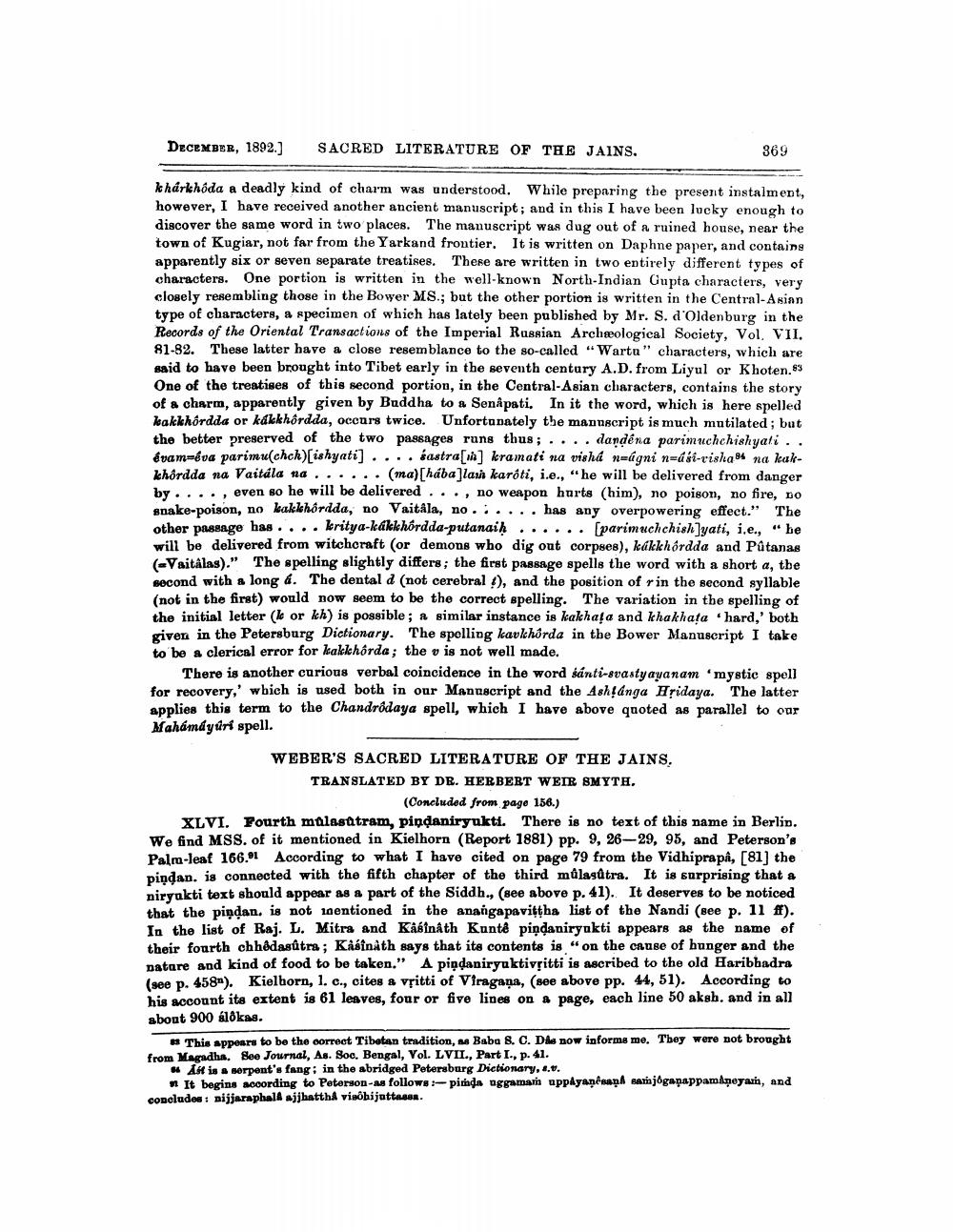________________
DECEMBER, 1892.)
SACRED LITERATURE OF THE JAINS.
369
khárkhóda a deadly kind of charm was understood. While preparing the present instalment, however, I have received another ancient manuscript; and in this I have been lucky enough to discover the same word in two places. The manuscript was dug out of a ruined house, near the town of Kugiar, not far from the Yarkand frontier. It is written on Daphne paper, and contains apparently six or seven separate treatises. These are written in two entirely different types of characters. One portion is written in the well-known North-Indian Gupta characters, very closely resembling those in the Bower MS.; but the other portion is written in the Central-Asian type of characters, a specimen of which has lately been published by Mr. S. d'Oldenburg in the Records of the Oriental Transactions of the Imperial Russian Archeological Society, Vol. VII, 81-82. These latter have a close resemblance to the so-called "Warta" characters, which are said to have been brought into Tibet early in the seventh century A.D. from Liyul or Khoten.$3 One of the treatises of this second portion, in the Central-Asian characters, contains the story of a charm, apparently given by Buddha to a Senapati. In it the word, which is here spelled kakkhôrdda or kdkkhôrdda, occurs twice. Unfortunately the mannscript is much mutilated; but the better preserved of the two passages runs thus; ....dandena parimuchchishyati .. évam=éva parimu(chch)(ishyati] .... bastra[i] kramati na visha n-ágni nousi-visha na kakkhôrdda na Vaitála na ...... (ma)[hába]lai karóti, i.e., "he will be delivered from danger by ...., even so he will be delivered ..., no weapon hurts (him), no poison, no fire, co snake-poison, no kakkhôrdda, no Vaitala, no.i.... has any overpowering effect." The other passage has .... kritya-kakkhôrdda-putanaik...... (parimuchchish]yati, i.e., “be will be delivered from witchcraft (or demons who dig out corpses), kákkhôrdda and Půtanas (eVaitalas)." The spelling slightly differs; the first passage spells the word with a short a, the second with a long á. The dental d (not cerebral !), and the position of rin the second syllable (not in the first) would now seem to be the correct spelling. The variation in the spelling of the initial letter (le or kh) is possible; a similar instance is kakhafa and khakhata hard,' both given in the Petersburg Dictionary. The spelling kavkhôrda in the Bower Manuscript I take to be a clerical error for kakkhôrda; the v is not well made.
There is another curious verbal coincidence in the word sánti-svastyayanam 'mystic spell for recovery,' which is used both in our Mannscript and the Ashanga Hridaya. The latter applies this term to the Chandrôdaya spell, which I have above quoted as parallel to our Mahámáyuri spell.
WEBER'S SACRED LITERATURE OF THE JAINS. TRANSLATED BY DR. HERBERT WEIR SMYTH.
(Concluded from page 156.) XLVI. Fourth malasatram, pindaniryukti. There is no text of this name in Berlin. We find MSS. of it mentioned in Kielhorn (Report 1881) pp. 9, 26-29, 95, and Peterson's Palm-leaf 166.1 According to what I have cited on page 79 from the Vidhiprapâ, [81] the pindan. is connected with the fifth chapter of the third mûlagútra. It is surprising that a niryakti text should appear as a part of the Siddh., (see above p. 41). It deserves to be noticed that the piņdan, is not woentioned in the anangapavittha list of the Nandi (see p. 11 ff). In the list of Raj. L. Mitra and Kasinath Kuntê piņdaniryukti appears as the name of their fourth chhôdasútra; Kasînàth says that its contents is on the cause of hunger and the patare and kind of food to be taken." A piņdaniryuktivșitti is ascribed to the old Haribhadra (see p. 458). Kielhorn, 1. c., cites & vșitti of Viragana, (see above pp. 44, 51). According to his account its extent is 61 leaves, four or five lines on a page, each line 50 aksh. and in all about 900 álókas.
This appears to be the correct Tibetan tradition, a Baba 8. C. Dhe now informs me. They were not brought from Magadha. See Journal, As. Soc. Bengal, Vol. LVII., Part I., p. 41.
# Ah is a serpent's fang: in the abridged Petersburg Dictionary, 4..
n It begins according to Peterson-as follows:- pinda nggamani uppdyanêsan samjóganappamameyas, and concludes: nijjaraphala sjjhattha visôbijattesse.




